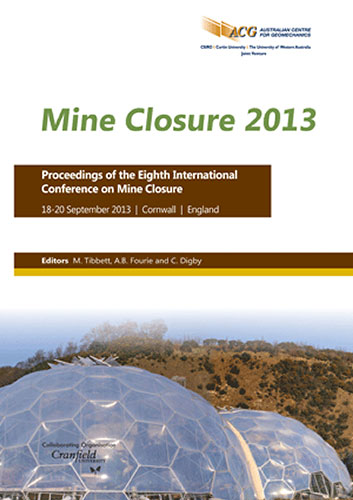A historical perspective on the subsidence effects of mine closure

|
Authors: Nelson, GR; Rowton, M; Kershaw, S; Bust, RA; Cooke, S; Tipper, L Paper is not available for download Contact Us |
DOI https://doi.org/10.36487/ACG_rep/1352_45_Nelson
Cite As:
Nelson, GR, Rowton, M, Kershaw, S, Bust, RA, Cooke, S & Tipper, L 2013, 'A historical perspective on the subsidence effects of mine closure', in M Tibbett, AB Fourie & C Digby (eds), Mine Closure 2013: Proceedings of the Eighth International Seminar on Mine Closure, Australian Centre for Geomechanics, Cornwall, pp. 537-546, https://doi.org/10.36487/ACG_rep/1352_45_Nelson
Abstract:
The UK Coal Authority has, since 1994, managed the public safety issues and subsidence claims due to ground instability created by historic coal mining. The principal causes of problems arise from shaft failures and subsidence due to collapse of shallow mine workings. The Authority receives approximately 1,000 such projects a year and accepts approximately 40% of them as the Authority’s liability. These projects cover most of the historic coalfields of England, Scotland and Wales and range from small holes in the ground to massive collapses tens of metres in diameter. The remediation of these effects costs the public purse somewhere in the region of £7 million per annum. The Authority has therefore dealt with many problems arising from closed mines in the UK and has an important perspective on the difficulties that mines can bring to communities many years after closure. This paper seeks to use the experience of the Authority’s Public Safety and Subsidence Division to highlight issues that need to be addressed at the time of mine closure. A principal issue, relevant to the better resolution of ground stability problems relating to mining collapses, is the need to collect, store and access accurate mining information over long time frames. Often collapses occur decades or centuries after closure, with a consequent risk of crucial information being lost over that time. The Coal Authority makes a valuable contribution in this area by acting as the main repository for historical mining plans and has invested over the years in increasing its ability to make this information available to the public and other bodies. This paper seeks, through a case study, to identify the particular information crucial to future treatment and the reason for its importance. These factors include, inter alia, information on position, depth, construction and treatment. The case study involving two voided shafts in a housing estate in Glasgow demonstrates the multiple difficulties faced and complexities in dealing with such situations. The paper also discusses how the general ground conditions and subsequent land use have an effect on the level of risk to the public and the particular problems they bring to the treatment of collapses. The paper further discusses how the Authority presently deals with the issue of land use with respect to the particular identified risks caused by historical coal mining.
References:
Healy, P.R. and Head, J.M. (1984) Construction over Abandoned Mine Workings, CIRIA Special Publication 32.
National Coal Board (1982) The Treatment of Disused Mine Shafts and Adits, NCB Mining Department (publisher), ASIN: B000T8B188
© Copyright 2025, Australian Centre for Geomechanics (ACG), The University of Western Australia. All rights reserved.
View copyright/legal information
Please direct any queries or error reports to repository-acg@uwa.edu.au
View copyright/legal information
Please direct any queries or error reports to repository-acg@uwa.edu.au